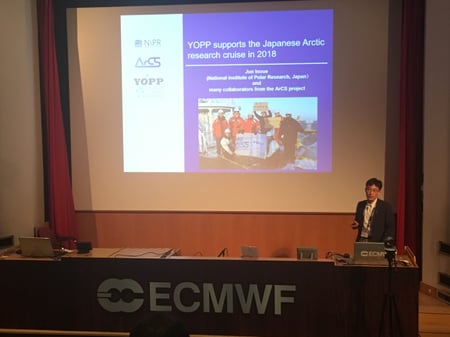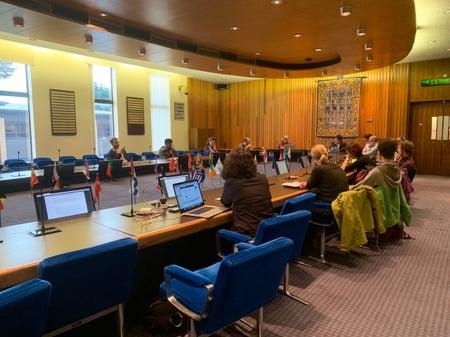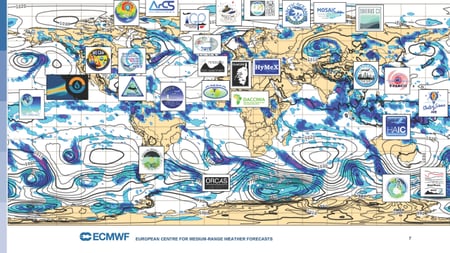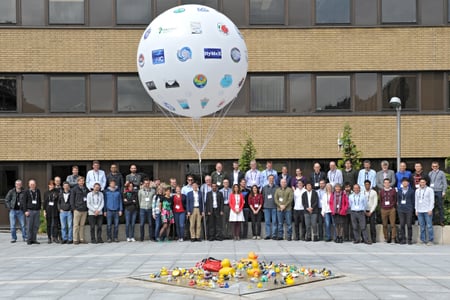Accurate weather forecasts form an imperative component of field observational campaigns. Accuracy is important, of course, but understanding the uncertainty is just as crucial. Observations on the hand are vital for Numerical Weather Prediction (NWP) models and centers for numerous reasons: improving forecasts through data assimilation, assessing their performance, and advancing model physics through process evaluations. Maximizing the values of observations and NWPs intuitively require communication between both parties. Aiming to initiate discussions in this context, a leading NWP center, European Centre for Medium-range Weather Forecasts (ECMWF) hosted a workshop during the 10th and 13th of June, 2019, titled “Observational campaigns for better weather forecasts” in Reading, UK. The workshop oral sessions included: model diagnostics using data, cloud physics, tropical cyclones, stratosphere, mountains, and winds, and polar processes. 4 members from the ArCS project participated with the Theme 1 PI presenting an oral talk from a perspective of a NWP user during the 2018 R/V Mirai field campaign while the others had poser presentations regarding sea ice forecast and air temperature biases and uncertainty of satellite-retrieved sea ice concentration. More broadly, discussions during the workshop included how to strengthen the link between observational campaigns and NWP centers, uncertainty estimation of the observation and models, and how to improve numerical models with past observational campaigns.
A key component of the workshop was a series of working group discussions covering these topics: from models to observations, from observations to models, and user voice on how ECMWF can better support field campaigns. Key recommendations from the discussions included:
- leading NWP centers and developers formulate a few model physics development goals and systematic errors; then, the observation campaigns and instrument developers can be guided by them to best address such issues.
- sharing of tools, data, and best practices among campaigns, where ECMWF (or other NWP center) provides a central repository for campaign tools and calendars etc. This also enables integration of NWP centers to various field campaigns from the start of projects, which improves the likelihood of observations enhancing NWPs.
- improving data discoverability such that those from previous campaigns could be “reused” to enhance weather forecasts and NWP and climate models.
Specific discussions related to the ArCS project included discussions of R/V Mirai experience using the ECMWF forecast as well as positive air temperature bias in their forecast. There was a discussion on the operational sea ice concentration and ice edge predictions of IcePOM model and ECMWF forecasts with a poster presentation. There is a negative bias in the ice edge predictions with ECMWF forecasts compared to the IcePOM, which is initialized using the AMSR2 data. These findings attracted the ECMWF’s sea ice modeler’s interest. This has possibly initiated ECMWF to investigate the impact of their weather forecasts by assimilating AMSR2 sea ice data instead of SSMIS derived sea ice data. On a similar note, aside from instruments and operational forecasts, considerable variability of sea ice concentration estimates between different algorithms and products were discussed with another Year of Polar Predictions (YOPP) members who were in attendance; while they were interested in the atmospheric feedback, Theme 1’s wave predictability was the focus of the ArCS poster presentation. Continued communication with these YOPP members would likely complement each other’s research, e.g., on topics related to surface drag parameterization over sea ice.
As a concluding remark, it should be understood that NWPs are restricted by given temporal and spatial resolutions as well as production time; as such, new insights gained from observations are not always suited to improve NWPs. In addition, NWP performance is indicated by metrics that are not necessarily related to the model physics. The discussions from the workshop clearly demonstrated interactions between observations and modelling parties are critical to improve the quality of weather forecasts. Lastly, while it was pointed out that z500 forecast skill has been on a continuous upward trend, the skill near the surface level has not improved as well. Given the polar regions already have generally lower skills, the ArCS project, from oceans to the atmosphere, has the potential to continue making solid contributions to the knowledge of the coupled atmosphere-ocean-ice-wave system.
Waruna De Silva and Tak Nose (The University of Tokyo / Members of Theme 1)

Dr. Inoue's presentation
Discussion (photo by @ECMWF)

Attendees of the WS
Group photo (photo from ECMWF website)




